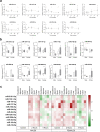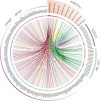Intestinal miRNAs regulated in response to dietary lipids
- PMID: 33144601
- PMCID: PMC7642330
- DOI: 10.1038/s41598-020-75751-w
Intestinal miRNAs regulated in response to dietary lipids
Abstract
The role of miRNAs in intestinal lipid metabolism is poorly described. The small intestine is constantly exposed to high amounts of dietary lipids, and it is under conditions of stress that the functions of miRNAs become especially pronounced. Approaches consisting in either a chronic exposure to cholesterol and triglyceride rich diets (for several days or weeks) or an acute lipid challenge were employed in the search for intestinal miRNAs with a potential role in lipid metabolism regulation. According to our results, changes in miRNA expression in response to fat ingestion are dependent on factors such as time upon exposure, gender and small intestine section. Classic and recent intestinal in vitro models (i.e. differentiated Caco-2 cells and murine organoids) partially mirror miRNA modulation in response to lipid challenges in vivo. Moreover, intestinal miRNAs might play a role in triglyceride absorption and produce changes in lipid accumulation in intestinal tissues as seen in a generated intestinal Dicer1-deletion murine model. Overall, despite some variability between the different experimental cohorts and in vitro models, results show that some miRNAs analysed here are modulated in response to dietary lipids, hence likely to participate in the regulation of lipid metabolism, and call for further research.
Conflict of interest statement
The authors declare no competing interests.
Figures






References
Publication types
MeSH terms
Substances
LinkOut - more resources
Full Text Sources
Medical
Molecular Biology Databases
Miscellaneous

